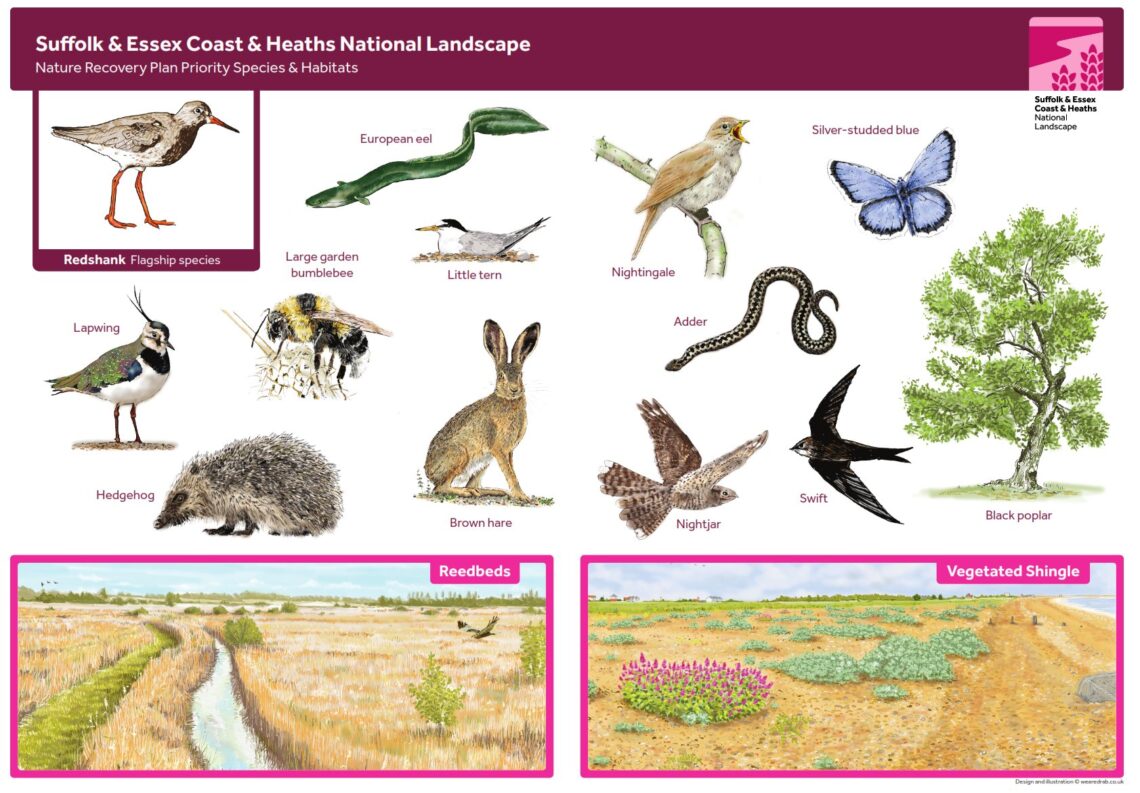Nature Recovery
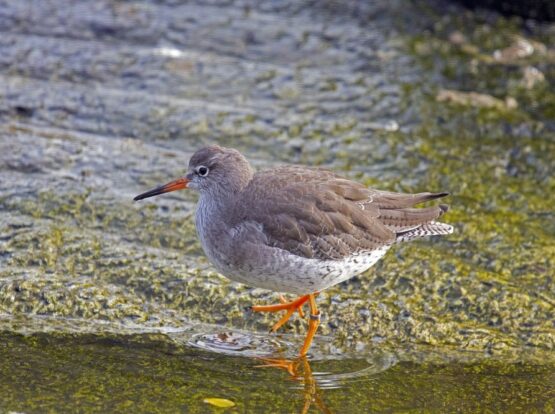
In the UK, sadly the abundance and distribution of species on average continues to decline. This worrying scenario was highlighted in the State of Nature Report 2019.
This report showed that of the 7,615 species found in England that have been assessed using the IUCN Regional Red List criteria, 971 (13%) are currently threatened with extinction from Great Britain.
The purpose of Nature Recovery is to engage partners to inspire and inform positive action. Through Nature Recovery work and projects we aim to conserve what remains, whilst also taking steps to reinstate what’s been lost.
Nature Recovery Plan
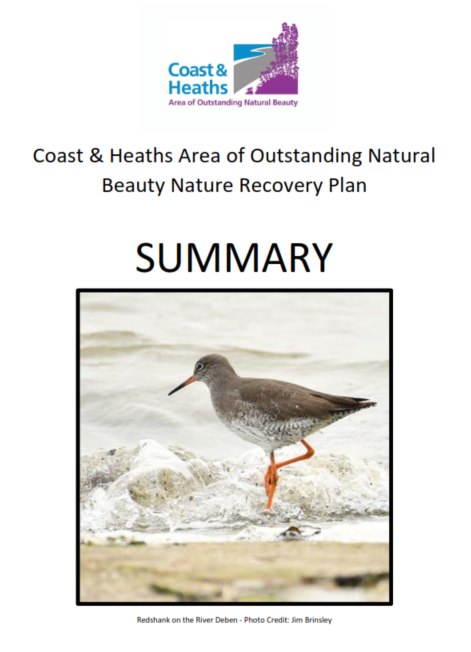
Nature Recovery Plans are a key commitment of the Colchester Declaration. The Nature Recovery Plan for the Suffolk & Essex Coast & Heaths National Landscape will relate to the National Landscape Management Plans as a spatial expression of the shared vision for beautiful, resilient landscapes rich in wildlife.
Through the implementation of the plan it is hoped that habitat and species recovery will be addressed at a landscape scale. The National Landscape will strive to ensure incentives such as the new Environmental Land Management scheme will play a key role in resourcing positive change in the National Landscape.
The Nature Recovery Plan will also relate to land outside the protected landscape boundaries. Their compilation will inform process and help gather data relevant to the later development of county-scale Local Nature Recovery Strategies which will be a statutory duty on Local Authorities arising from the Environment Act.
The Nature Recovery Plan was co-created with a wide range of stakeholders across the landowning and conservation sectors and the wider community.
A summary of the plan is available to download. The full nature recovery plan is available upon request (parts one & two) - please email coastandheaths@suffolkandessex-NL.org.uk.
Priority Species
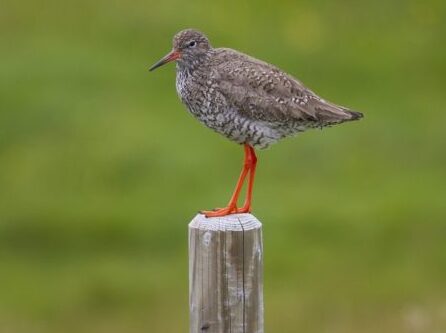
Flagship Species: Redshank
As part of our Nature Recovery Plan, the Redshank was chosen to become the flagship species for the Suffolk & Essex Coast & Heaths National Landscape.
The redshank (Tringa totanus) sometimes referred to as the Sentinel of the Marshes was selected by Suffolk & Essex Coast & Heaths National Landscape environmental partners representing 16 organisations with an interest in the wildlife.
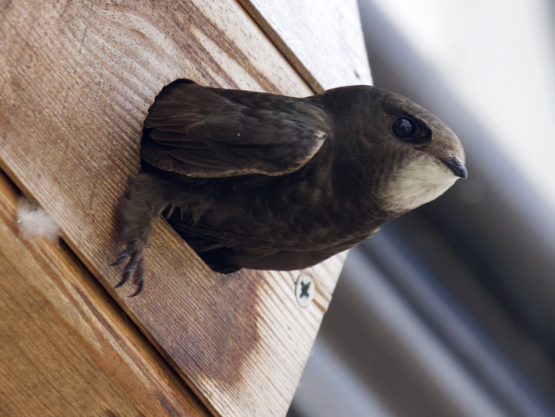
Priority Species: Swifts
Swifts have declined by 45% in just under 20 years in the UK! Their nest sites are often lost when old buildings are knocked down or repaired and many new buildings have no nooks and crannies for them to nest in.
You can help swifts by installing nest boxes on tall buildings and playing their calls to attract them. If you live in the Suffolk & Essex Coast & Heaths National Landscape and think you may have a suitable location for a set of six swift boxes, apply for a free set, along with a swift caller system.
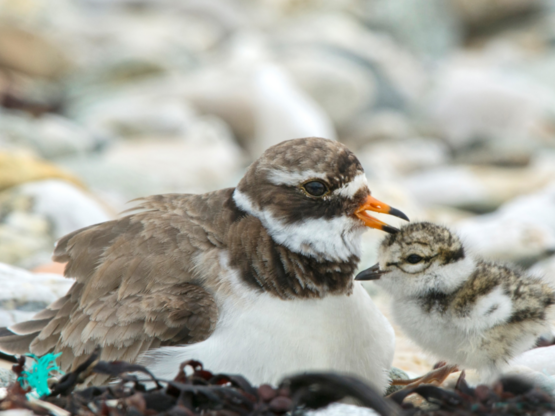
Priority Species: Ringed Plover
Ringed Plover are vulnerable to habitat loss and disturbance, hence their population has declined by 59% in the UK in only 25 years. Between April-July they lay four tiny eggs in a scrape on the ground which are neatly arranged with the pointed ends always in the centre of the nest.
Work is being done to raise awareness of the ringed plover and educate visitors and local residents on how they can help support the ringed plover population and avoid some of the behaviours that can cause disturbance.

Priority Species: Hedgehogs
The hedgehog is a priority species in the Suffolk & Essex Coast & Heaths National Landscape Nature Recovery Plan. In the past decade over a half of rural hedgehogs and a third from towns and cities have been lost.
Areas in and around towns and villages can be excellent habitats for hedgehogs, and hedgehogs often prefer them over farmland. We are working to create hedgehog-friendly gardens in the Suffolk & Essex Coast & Heaths National Landscape.
As part of our nature recovery work to support wildlife & habitats in the National Landscape, we have several priority species and landscapes. You can download our fun poster showing priority species and habitats in the National Landscape
Landowner help needed to benefit nature
Can you help to achieve ambitious targets for nature recovery within the Suffolk & Essex Coast & Heaths National Landscape?
In response to the Government’s Environmental Improvement Plan (2023) and the National Landscapes Colchester Declaration (2019), the National Landscape is working in partnership with landowners and organisations to achieve significant, and measurable, benefits for nature.
Ambitious targets have been set out for each National Landscape and National Park by the Department for Environment, Food and Rural Affairs for a range of targets covering the following:
- Restoring/creating wildlife rich habitats
- Increasing tree canopy and woodland cover
- Planting hedgerows
- Enabling natural regeneration
- Creating ponds and wetlands
We are looking for landowners/land managers to help us deliver the work to meet these targets. If you have land and want to improve its biodiversity potential or change the way it is used e.g. by planting trees or sowing a wildflower meadow, we would love to hear from you.
This would enable us to record your project, including it in demonstrating nature recovery across the National Landscape. In return we may be able to help support you and the successful delivery of your project, by providing:
- Informal advice from experienced conservation staff
- Volunteer support to turn your vision for nature into reality
- Signposting towards further guidance and/or potential funding
For information and to register your interest, please email [email protected] or phone 01394 445225.
The Colchester Declaration
The National Landscapes Association made a collective declaration on nature in National Landscapes in 2019.
Set against a backdrop of unprecedented concern for the future of the natural world, and intergovernmental reports that the current global response to the effects of human impact on nature is insufficient, the Association decided to set out a strategic plan in the Colchester Declaration (PDF).
In order to fulfil the ambitious target laid out in the Colchester Declaration, each National Landscape is now preparing a Nature Recovery Plan.
By 2030, we pledge to achieve the following ambitious targets to help reverse the decline of nature:
- At least 200,000 hectares of SSSI’s in National Landscapes will be in favourable condition
- At least 100,000 hectares of wildlife rich habitat outside of protected sites will have been created/ restored in National Landscapes to further support the natural movement of plants and animals
- At least 36,000 hectares of new woodland will have been planted or allowed to regenerate in National Landscapes following the principle of the right tree in the right place
- At least thirty species relevant to National Landscapes will be taken off the list by 2030 by each National Landscape immediately adopting a species on the threatened list and by preparing and delivering a Species Action Plan

